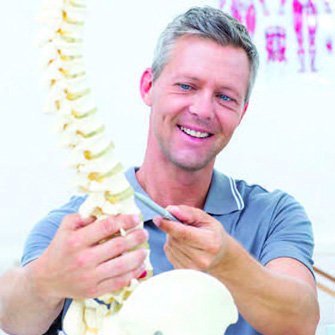What is chiropractic?
Chiropractic is a healthcare profession or discipline that diagnoses, treats and prevents the mechanical disorders of the neuromusculoskeletal system, especially the spine. Chiropractic care is capable of improving general health based on the theories that these mechanical disorders affect general health through the nervous system that exits from the spinal cord housed in the spine column.


What is an adjustment?
Chiropractic manipulation therapy (CMT), also called adjustment, is the manipulative technique involving hands-on manipulation of the spine or other joints, with hands (manual manipulation), and/or via special tables (such as drop tables, flexion-extension tables), and/or by using some devices (like activator), etc.
Who are chiropractors?
Chiropractic professionals are doctors of chiropractic, DC’s, or chiropractors. Although it has many similar attributes of primary care physicians (PCPs) for general health, a chiropractor is usually considered as a medical specialist like a dentist or ophthalmologist. The education that a chiropractor receives is very similar to that of a medical doctor (MD). Both DC’s and MD’s receive a Bachelor’s degree followed by 3-4 years of specialized medical training including internships and rotations. Both receive extensive training in the basic sciences such as anatomy, physiology, histology, pathology, microbiology, radiology and neurology, etc. The two professions begin to differ in regards to treatment protocols. Medical doctors focus on learning about medications and surgery while chiropractors learn to treat with their hands using adjustments, acupuncture and soft tissue mobilizations.


What do chiropractors do?
Chiropractors provide health care including medical history taking, physical examination, laboratory testing and diagnostic imaging, to determine the diagnosis and perform treatment. We take a distinguished medication -free, surgery-free natural approach, different from conventional medicine in treating and preventing health problems.
CONTACT US
How We Can Help You
To make an appointment call us +1-713-234 1014 or click here…
Does an adjustment cause pain?
A correctly performed adjustment should not cause any pain. Minor muscle soreness may occur following an adjustment, similar to a feeling you may get after working out at the gym. This can be minimized after the adjustment by using ice, increasing water intake and consuming a high protein meal. This discomfort, as with intense exercises, usually resolves within 12 to 48 hours. Chiropractic care is one of the safest forms of medicine because it is conservative, non-invasive and there is no risk of drug interactions.


What happens during a visit to the chiropractor?
Early chiropractic used manipulation as the major form of treatment. Modern chiropractors have incorporated a variety of therapies to achieve a favorable result. A typical visit may include a tailored combination of chiropractic manipulation, acupuncture, passive modalities, active exercises, and nutritional counseling or supplementation. We focus on the source of the problems and educate the patient about treating the body in a holistic approach.
What is DJD (Degenerative Joint Disease)?
DJD, also known as osteoarthritis, is the progressive wear and tear of joints. Joint degeneration inevitably occurs in all individuals, as we get older. Symptoms of DJD generally include pain or tenderness in the joints, stiffness or a grating sensation during movements. Symptoms in later stage are muscle atrophy, ligament laxity and formation of bone spurs.


How common is DJD?
DJD is the most common form of arthritis, and the leading cause of chronic disability in the US. DJD occurs throughout the world in all races, and it currently affects about 27 million individuals in the US. Since joint degeneration is a part of the aging process, eventually everyone will develop some symptoms of degenerative disorders. DJD not only affects the elderly associated with aging, but also affects any of us due to a sedentary lifestyle. Can we prevent DJD? Chiropractic care can greatly slow down and prevent the progression of DJD, although we cannot completely stop joints from degeneration. Good posture as well as avoiding joint injury can help prevent DJD. The process of joint degeneration can be sped up with significant macrotrauma, such as sports injuries or motor vehicle accidents. It can also be caused by mild but repetitive micro-trauma such as bad posture or occupational disorders.
How is posture related to DJD?
Posture is the body position in which you hold your body weight against gravity while standing, sitting, lying down or moving. Good posture gives you a balanced position where body weight is distributed evenly on joints, with the least strain on supporting muscles and ligaments, so that your body is able to function optimally. Poor posture puts excess stress on the joints, increases wear and tear to the joints so that degeneration occurs quicker.
How can I achieve good posture?
Postural training can help delay onset of symptoms related to DJD. For instance, good standing posture presents when a vertical line can be drawn passing through the ears, shoulders, hips, knees and ankles. In this position the joints are placed under the least amount of stress because the body weight is evenly distributed. Good sitting posture occurs when the head is positioned directly over the neck, rather than jutting forward.


How can young people benefit from posture training?
Good posture early in life ensures the healthy development of your body and prevents DJD later. Poor posture can be corrected before any joint damage is done. Posture training will benefit young people greatly by teaching them good habits they can maintain for their lifetime.
How can older adults benefit from chiropractic care?
Chiropractors can help older adults alleviate pain associated with the aging process and allow you to focus on hobbies or activities that you did in the past. Chiropractors can help maintain a high quality of life and independence function as well as by improving mobility, flexibility, strength and balance. Is chiropractic care covered by insurance? Most major insurance companies cover chiropractic care. It is best to check with your insurance company to determine exact benefits. Our doctors have contracts with most major insurance companies.

